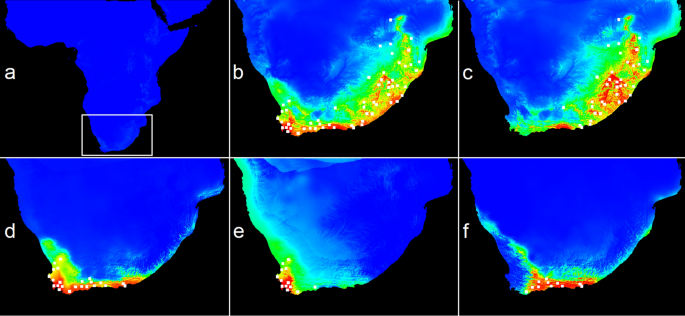古气候生态位模型揭示了南非鼩鼱Myosorex varius的系统地理历史和Myosorex属(哺乳动物,鼩科)从东非的殖民路线
IF 16.4
1区 化学
Q1 CHEMISTRY, MULTIDISCIPLINARY
引用次数: 0
摘要
摘要Myosorex varius是南非的一种多面手鼩鼱,它被发现由几个遗传分支组成。一个北方分支居住在南非东部的草原和稀树草原上,那里比较温和,夏季降雨较多。南部支系占据南部的丰水区,可进一步分为西部支系占据冬季降雨区和东部支系占据季节性降雨区。非洲Myosorex属的非南非成员主要局限于沿东非裂谷系统的孤立山地栖息地。本文采用古气候生态位模型研究了上新世和更新世气候变化对大芽孢杆菌及其分支和属整体分布的影响。研究结果表明,冰期范围扩张和间冰期破碎化的反复循环是造成目前不同物种系统地理格局的原因。基于它们与降雨带的紧密排列以及尽管有接触区域但缺乏遗传混合,这些(亚)进化支很可能在当地适应了各自的区域。早期的气候波动使该属沿着东非裂谷系统从东非向南“跳岛”,在较冷的时期扩大活动范围,在较暖的时期撤退到山区避难。目前Myosorex物种所占据的地区与预测的山地避难所基本一致,这些避难所使它们能够在之前的温暖时期生存下来。本文章由计算机程序翻译,如有差异,请以英文原文为准。

Palaeoclimatic niche modelling reveals the phylogeographic history of the South African shrew Myosorex varius and the colonisation route of the genus Myosorex (Mammalia, Soricidae) from East Africa
Abstract Myosorex varius is a South African generalist shrew, which has been found to consist of several genetic clades across its range. A northern clade inhabits the more mesic, summer-rainfall areas of grassland and savannah in the east of South Africa. A southern clade occupies areas of fynbos in the south, and can be further divided into a western subclade occupying winter-rainfall areas and an eastern subclade occupying areas with aseasonal rainfall. Non-South-African members of the African genus Myosorex primarily are limited to isolated montane habitats along the East African Rift System. Here, we used palaeoclimatic niche modelling to examine the effects of Pliocene and Pleistocene climate change on the distributions of M. varius , its clades and the genus as a whole. Results indicate that repeated cycles of range expansion during glacial periods and fragmentation during interglacials are responsible for current phylogeographic patterns within M. varius . Based on their close alignment with rainfall zones and lack of genetic mixing despite areas of contact, it is likely that these (sub)clades are locally adapted to their respective areas. Earlier climatic fluctuations allowed the genus to ‘island hop’ south from East Africa along the East African Rift System, expanding in range during cooler periods and retreating to montane refugia during warmer periods. Areas currently occupied by Myosorex species largely correspond with predicted montane refugia that have allowed them to survive previous warm periods.
求助全文
通过发布文献求助,成功后即可免费获取论文全文。
去求助
来源期刊

Accounts of Chemical Research
化学-化学综合
CiteScore
31.40
自引率
1.10%
发文量
312
审稿时长
2 months
期刊介绍:
Accounts of Chemical Research presents short, concise and critical articles offering easy-to-read overviews of basic research and applications in all areas of chemistry and biochemistry. These short reviews focus on research from the author’s own laboratory and are designed to teach the reader about a research project. In addition, Accounts of Chemical Research publishes commentaries that give an informed opinion on a current research problem. Special Issues online are devoted to a single topic of unusual activity and significance.
Accounts of Chemical Research replaces the traditional article abstract with an article "Conspectus." These entries synopsize the research affording the reader a closer look at the content and significance of an article. Through this provision of a more detailed description of the article contents, the Conspectus enhances the article's discoverability by search engines and the exposure for the research.
 求助内容:
求助内容: 应助结果提醒方式:
应助结果提醒方式:


